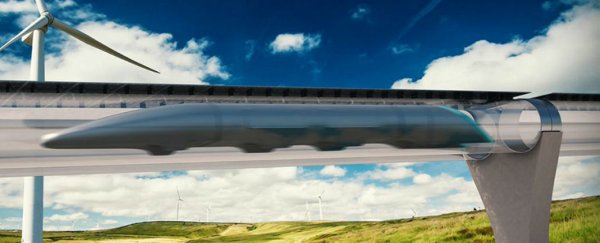Elon Musk's Hyperloop - a train that will transport people around America at 1,200 km/h (800 mph) - might not be so far-fetched after all, thanks to a group of engineers that are crowd-funding and crowd-sourcing it into reality.
Inspired by how, a hundred years ago in New York, a cat was sent through the mail via pneumatic tubes, Musk - the billionaire CEO of Tesla Motors and SpaceX - proposed the Hyperloop late last year, but admitted that he didn't actually have the time to build it. But California-based startup, JumpStartFund, has announced that it's gathered together a crack team of 100 engineers that have been given permisson by Musk to take the plans and run with them. And, as Alex Davies reports at Wired, they're bringing money and ideas in from all over the place to help them do it.
"This isn't a Subreddit trying to solve the Boston Marathon bombing," says Davies. "These gals and guys applied for the right to work on the project (another 100 or so were rejected) and nearly all of them have day jobs at companies like Boeing, NASA, Yahoo!, Airbus, SpaceX, and Salesforce. They're smart. And they're organised."
Now known collectively as Hyperloop Transportation Technologies, Inc, the group hopes to have a feasibility study on the system completed by mid-2015. This objective report will lay out the strengths and weaknesses of the Hyperloop proposal, including considerations such as its potential impacts on the environment, cost of resources, and legal requirements, depending on where it's built.
So far, the team says it's made progress in three main areas - the Hyperloop capsules, stations, and route.
The route was originally proposed to run from San Francisco to Los Angeles in the US, and the 600-km (381-mile) trip would take just 30 minutes, but critics noted that regular earthquakes in the region would make this unfeasible. And how would it get across San Francisco Bay? So Hyperloop Transportation Technologies are looking at other routes, Los Angeles to Las Vegas, perhaps, or even somewhere in Dubai, where political hurdles are less imposing than in the States. "We would love to see LA to San Francisco, but our primary goal is to build the Hyperloop," CEO Dirk Ahlborn told Wired. Ahlborn thinks that the train could even reach 4,000 mph, which would take it from New York to China in two hours.
A group of 25 graduate architecture students from the University of California, Los Angeles, are also working on potential routes through Asia and Europe.
For the capsules that passengers would actually ride in, Davies describes how the team decided on what it calls a 'bubble strategy'. "There's the swanky capsule, the one with fancy doors and windows, that pulls into the station," he says. "Passengers get in, and that capsule enters an outer shell as it's loaded into the tube. The outer shell is built to handle the ride, and has the air compressor and other needed bits." There would be freight, economy and business class capsules.
As for the stations, Hyperloop Transportation Technologies imagines that the passangers would arrive, drop their bags off with a robot for depositing on the Hyperloop, and would pass through an automatic walkway with a metal detector that beams down from above.
Once passengers have boarded their bubble capsules, they will travel in one of two stacked tubes, with multiple capsules travelling in opposite directions in each tube. "When a capsule reaches a station, the bubble slides out sideways and onto the platform, and the passengers unload," Davies reports at Wired. "Then the capsule is moved to the opposite tube and ready to get going again."
Watch the video above to see just how revolutionary this transport system could be. We're probably 10 years out from it being commercially viable, but we didn't have Wikipedia, Facebook or Google Maps a decade ago, so who knows? Head to Wired to read Davies' report about what the team is planning to do next.
It's hard not to get a little excited about it. Although maybe we'll all be zipping around in our own flying cars within the next decade anyway. The race is on.
Source: Wired
